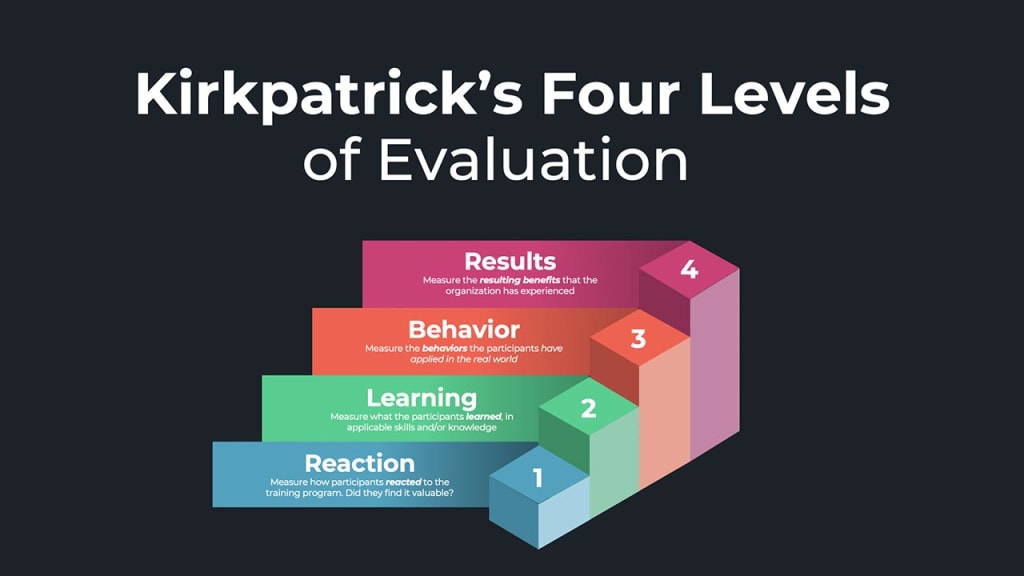This is how I felt about my training and assessment level 4 course
"Kirk Patricks evaluation model is very useful in evaluating training programs. It helps us to understand the strengths and weaknesses of our programs in a systematic way so that we can make improvements."

I learned about Kirk Patricks Evaluation Model for training and learning. The model has four levels of evaluation.
First level - Reaction
The first level of this course was very helpful. It gave me a good base for the rest of my training and I learned some new things that i had never even heard before. For example, I learned about how to treat someone who is having a seizure, or what CPR is and how to do it.
In general, this level was quite good because it made sure that you knew everything about first aid before moving onto the next step of your training.
Second level - Learning
As a student, I really enjoyed the training sessions. They were interesting and fun, and made me want to come back for more. The instructors were very knowledgeable about the subject matter, and they taught it in an interactive way in order to keep everyone's attention. The small class size also helped with this, because we were able to have conversations about things that weren't being taught in class at that time; it made learning more enjoyable as well as informative.
Third level - Behavior
The third level is the level where your training is put into practice. This means that at this stage, you should begin to apply your knowledge and skills in real situations.
The third level is also when the training (as well as the learner) is evaluated. You need to demonstrate both theoretical and practical knowledge. This can be done through a written examination or an assessment of a specific situation that demonstrates what you have learned during this course.
A final evaluation of your completed study will take place at this time as well, and it will determine whether or not you meet the required standards for being awarded certification (or other credentials).
Fourth level - Results
I feel that this is a good opportunity to stress the importance of understanding how to use the results of your training and assessment. It is also important to understand what it means when we say "results". This may be a little confusing at first, so let us go over some examples in order to clarify things:
- When you complete this course and do well on both the training and assessment, you will have results from completing this course.
- If you fail both parts of this course, then you will not have any results from completing it (even though many people like myself would argue that failure should count as one).
- The above scenario would also apply if you did well on one part but poorly on another - you could still have no results from doing poorly on either part or both parts (depending upon which ones).
If we take a closer look at these scenarios and look at all possible combinations of successes/failures across both parts, we can see that there are actually over 6 billion different ways in which one person might complete their studies here at Level 4!
Kirk Patricks evaluation model is very useful in evaluating training programs.
Kirk Patricks evaluation model is very useful in evaluating training programs. It is used to evaluate training outcomes, and it is also used to evaluate training effectiveness. The Kirk Patricks evaluation model was developed by Dr. Kirkpatrick who was a psychologist at the time he proposed this model.
The Kirk Patricks evaluation model consists of four levels:
- Level 1: Reaction - This level focuses on how well the trainee accepted your program and whether or not they found it helpful or not helpful for their job performance requirements.
- Level 2: Learning - This level focuses on how much knowledge or skill has been gained from the program by a trainee through direct instruction and practice exercises that were given during your session.
- Level 3: Behavior Change - This level focuses on how well did you change someone's behaviour as a result of implementing your program in their work environment? For example; if you trained a group of people about safety procedures then you may want to ask them if there were any changes in their behaviour as a result of being trained about safety procedures (e..g., did they follow safety rules more strictly). Or if you trained them about customer service policies then you might want to ask them if their customer service skills have improved since being trained (e..g., do they greet customers with "Hello" now instead just asking them what they need?).
Conclusion
Kirk Patricks evaluation model is very useful in evaluating training programs. It helps us to understand the strengths and weaknesses of our programs in a systematic way so that we can make improvements. I think this process will be very helpful when working as an educator because it allows me to see if my students are improving or not based on their performance in tests which will help me tailor future lessons accordingly.






Comments (1)
Your arranged Reaction, Learning, Behavior, and Result are so good. I strongly agree with you. Your points are excellent. https://spacebarclickergame.com